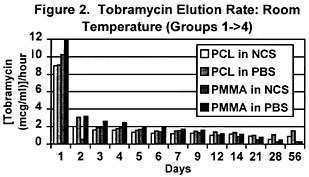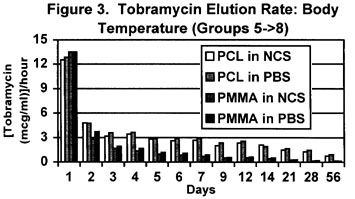
Session IX - Tibia
In Vitro Elution Characteristics of Tobramycin from Bioabsorbable Polycaprolactone Beads: A Novel Paradigm for Local Antibiotic Delivery to Infected Wounds
Tim A. Burd, MD; Kent J. Lowry, MD; Jeff O. Anglen, MD; William C. Allen, MD; University of Missouri-Columbia Hospital and Clinics, Columbia, Missouri
Purpose: To compare the in vitro elution characteristics of tobramycin from polycaprolactone (PCL), an absorbable polymer, to polymethylmethacrylate (PMMA), the most commonly used antibiotic vehicle for local antibiotic delivery to infected wounds.
Methods: One hundred molded 6mm PMMA beads containing 6% tobramycin were divided into 20 groups of 5 beads each (average group weight: 815mg). One hundred hand-rolled 6mm PCL beads with the same concentration of tobramycin separated into similar groups (average weight = 865mg.) The average surface area for each group was 548mm2 for PMMA
|
|
|
| Group 1 | PCL in NCS @ 250C |
| Group 2 | PCL in PBS @ 250C |
| Group 3 | PMMA in NCS@ 250C |
| Group 4 | PMMA in NCS @ 250C |
| Group 5 | PCL in NCS @ 370C |
| Group 6 | PCL in PBS @ 370C |
| Group 7 | PMMA in NCS @ 370C |
| Group 8 | PMMA in PBS @ 370C |
and 564mm2 for the PCL group. Each group of beads was completely submerged in 10ml of either phosphate-buffered saline (PBS) or sterile newborn-calf serum (NCS). Eight groups of beads were assessed with five replicates per group (Figure 1). Samples of fluid were taken at 24 hour intervals for 1 week, then at days 9 and 12 and at 2,3,4, and 8 weeks. After sampling, the beads were washed and fluid replaced. Tobramycin levels for each group of beads were quantified via fluorescent polarization assay.
At eight weeks, tobramycin activity was assessed. Trypticase soy agar (TSA) plates were homogeneously streaked with Pseudomonas aeruginosa (40 plates) and Staphylococcus aureus (40 plates). A 7.5mm-diameter central well was created in the agar; 100ml of the tobramycin-PBS eluent at 8 weeks was then placed into the central well, and the TSA plates were then incubated overnight at 370C. After 24 hours, the zone of inhibition for each plate was measured.
Results: Elution rates for beads at 250C are shown (Figure 2). 
At 24 hours the rates of tobramycin elution were similar; this pattern remained relatively constant up to three weeks. At 3 weeks the PCL beads had elution rates approximately twice the PMMA beads (group 1: 0.9 mg/ ml/hr; group 2: 1.02 mg/ml/hr vs. group 3: 0.5 mg/ml/hr and group 4: 0.77 mg/ml/hr). This trend continued until eight weeks at which time the PCL beads had > 4 X's the elution rate of PMMA beads (group 1: 0.9 mg/ml/hr; group 2: 1.5 mg/ml/hr vs. group 3: 0.29 mg/ml/hr and group 4: 0.28 mg/ml/hr) At eight weeks degradation of the PCL was visibly present .

By comparison, the beads studied at 370C showed that PCL had greater rates of elution at each time interval after the first 24 hours than PMMA beads (Figure 3). In the specimens at body temperature, the elution rate of tobramycin from PCL beads was doubled at 72 hours. By the end of the time intervals (eight weeks) the elution rate for PCL beads was ~ 6.5 X's that of PMMA. The total amount of tobramycin eluted over the eight week period was substantially greater in the PCL specimens (38.9% tobramycin eluted [all PCL groups]) compared to the PMMA beads (20% [all PMMA groups]).
The tobramycin activity measured at 8 weeks showed that all replicates had zones of inhibition present. Thus, all samples had tobramycin that was still active against both Gram-positive and Gram-negative organisms.
Conclusions: 1) Polycaprolactone beads impregnated with tobramycin have better elution characteristics in vitro than the current standard of local antibiotic delivery system using polymethylmethacrylate beads. 2) Our data suggests that PCL beads deliver equivalent or greater concentrations of antibiotic and elute more total antibiotic over an eight-week period and 3) tobramycin remains active against both Gram-positive and Gram-negative microorganisms in vitro up to eight weeks.
Discussion: Local antibiotic administration for the treatment of musculoskeletal infection has become an established modality, both in conjunction with, and in place of, systemic antibiotics. Methods of administration have included devices such as implantable antibiotic pumps and PMMA beads containing antibiotic. As the antibiotic diffuses out of the beads into the surrounding tissue, local concentrations of antibiotic are much higher than can be achieved with systemic administration and without the risks of systemic toxicity. The major disadvantages of PMMA as a drug-delivery system are that it requires removal of the beads after the antibiotic has leached out, as well as its inhibitory effects on macrophages and other immune cells. To overcome these problems, we have studied the elution characteristics of polycaprolactone and have found them to be better than PMMA over time. Future studies will involve implanting antibiotic-impregnated PCL beads into an infected animal wound to assess the in-vivo characteristics of this potentially useful material as an absorbable drug- delivery device.